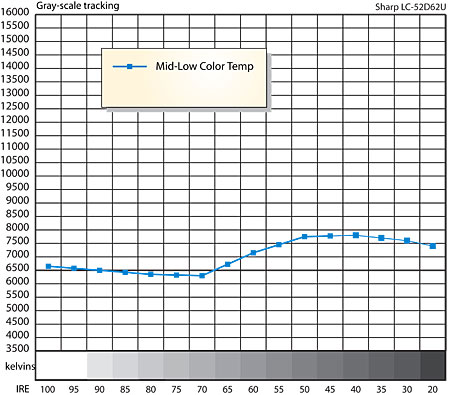Sharp LC-52D62U LCD Flat Panel HDTV Tests and Measurements
Overscan on the HDMI inputs was non-existent at 1080i with the Dot by Dot mode engaged. At 720p it was similarly absent with the Full Screen mode, but more like 3% all the way around in Stretch at both 1080i and 720p. 480p over HDMI was 3% in all four directions. Crosshatch patterns revealed virtually perfect geometry with 480p, 720p and 1080i. These results were very similar in component video, with Overscan occasionally going closer to 4% in some areas of the screen with Stretch mode, which is still perfectly acceptable.

The Sharp is a genuine 1080p set. On HDMI it was able to display essentially perfect response, at the highest frequencies, of single pixel width luma bursts at 1080i from my Accupel signal generator and a 1080i/p test signal sampler disc by Stacey Spears and Don Munsil played back on the Toshiba HD-XA2 HD DVD player. The Spears/Munsil disc has horizontal and vertical bursts and I saw just about perfect performance with both at 1080i or 1080p from the Toshiba.
But note that the Sharp only displayed this level of perfection when the Dot by Dot View Mode was selected. The performance was still better than respectable when the Stretch mode was engaged, with the single pixel width line structures remaining largely intact, but there was noticeable banding in the single pixel bursts and some unevenness in the double pixel width bursts. My advice is to use Dot by Dot for the most naturally detailed and pristine performance with 1080i/p signals.
Sticking with the HDMI inputs, the Sharp showed generally terrific response on luma bursts from the Accupel at 720p and 480p as well, but at 720p there was a very slight unevenness at the highest frequencies that only seems off in comparison to the perfection with 1080i/p and the Dot by Dot mode engaged. It also wouldn't lock onto a 480i signal from the Accupel over its HDMI inputs.
On Chroma bursts over HDMI the Sharp didn't resolve the highest frequency areas in the bursts at 480p, 720p or 1080i. These areas were rendered as black and white. It was perfect at double pixel width but showed no color whatsoever in the highest frequencies. This surprised me, especially with 480p, but I can't say I saw anything in program material to fault that would point back to this result.
Moving to component video, there was noticeable rolloff at the highest frequencies of the Accupel's luma bursts at both 720p and 1080i. The line structure was faint and grayed out, slightly more so at 720p than 1080i. These results were obtained with Dot by Dot and Full Screen View Modes, and switching to Stretch added banding to the problems. 480p component was fine to the limits.
Switching to the chroma bursts from the Accupel, there was a noticeable improvement in the highest frequency bands with component. I saw good color gradation even at 720p and 1080i. But it's more likely that you'd notice the increased high frequency luma response of the HDMI video more than the improved color response of component video, so using HDMI sources is highly recommended.
Using the Silicon Optix HD HQV Benchmark the Sharp displayed excellent but not perfect performance with 1080i deinterlacing. The video-based jaggies tests came out at near perfection, which is excellent. But the Film Detail Test indicated that the Sharp can't perform 3/2 pulldown with film-based 1080i sources. This isn't the deal killer it seems. The Sharp's performance was right in line with the Gennum processing in my Marantz VP-11S1 projector and the Anthem AVM 50 surround processor. And 1080i looks excellent with all three of these devices deinterlacing 1080i. But, there's another level still, and this set, like most otherwise excellent displays and processors (including my own current reference gear), can't quite get there.
Inputting 480i over HDMI from the Pioneer Elite BDP-HD1 Blu-ray player I ran the Silicon Optix HQV Benchmark and saw very mediocre deinterlacing performance in most respects. Apparently the deinterlacing of 1080i was deemed paramount. Use a good progressive or upconverting DVD player with this set for the best results.
On the grayscale, at the Mid-Low setting the Sharp bounced between 7400K and 7800K at the low end of the scale- from 20IRE to 60IRE- and then settled in between 6300K and 6500K from 70IRE to 100 IRE. It was minus green to plus blue all the way across, which isn't a particularly bad way to go even if these results are far from ideal. It actually wasn't distractingly bad with program material, but I'd prefer to be able to adjust it to more accurate results. At the Low setting the top end hovered around 5500K, which is too sepia toned for anything other than black and white films. Middle wasn't bad on top, but was over 9000K at the low end, which is noticeably blue with program material. Black suits would look cool, literally. With digital domain RGB signals the Sharp displayed above white and below digital black.

























































